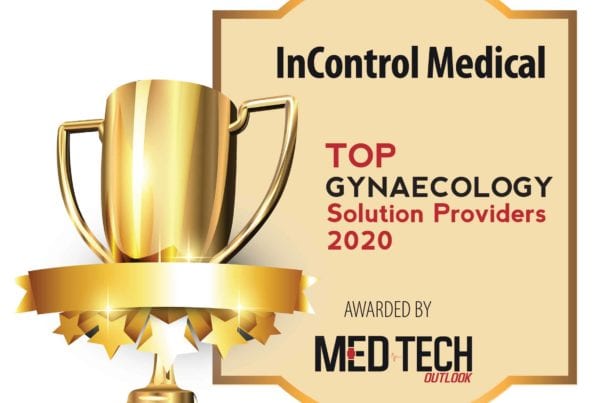
How InControl Remedied a Life-long Challenge
An overactive bladder is never a good sign. 60 million women, especially over the age of 40, suffer from the inability to control their bladder as the strength of their pelvic floor muscles is compromised with age. While bladder accidents on their own are quite uncomfortable, having to go through the embarrassment of it in public is the most undesirable experience.
Known widely as urge urinary incontinence, this condition occurs when the detrusor muscle in the bladder loses its connection with the bran, and the bladder muscles start squeezing involuntarily. Incontinence is disproportionally more common in women than men, and its likelihood increases with age. Other than urge incontinence, there also exists stress urinary incontinence which arises from weak pelvic floor muscles. The number on cause for weak pelvic floor muscles is the gestation period, which stresses these muscles out.
Unlike stress incontinence, which usually results in a slight leakage of the bladder, which usually results in a slight leakage of the bladder, urge incontinence causes the muscles to squeeze hard enough to empty the bladder entirely. While not life-threatening, the effect that urinary incontinence can have on a patient’s social occupational, physical, psychological, and sexual aspects of life is a harrowing experience. About 70 percent of women, due to stigma and humiliation, never bother to inform their physician nor seek further knowledge or assistance about incontinence because they believe the only solution would be surgery or medication. Even with medication such as commonly prescribed anticholinergic drugs, studies have shown that extended use of these drugs for incontinence can heighten the chances of dementia by 50 percent.
Breaking down the barriers between women and the cure of incontinence, InControl Medical, developer and manufacturer of urinary incontinence devices, has developed a range of cutting-edge home medical devices, empowering women to regain control of their lives. “Built with easy-to-clean, medical-grade silicone, all our devices are made in the U.S. by women. For women,” says Herschel Peddicord founder and CEO of InControl Medical. For easier availability of their devices the company is also a Medicare provider, enabling women to order InControl’s devices through Medicare or directly from the company’s website and use it in the comfort of their homes. “With our devices designed to cure incontinence, we strive to make incontinence a thing of the past,” says Peddicord.
The Beginnings of a Life-Changing Solution
Interestingly, a close family member’s battle with urinary incontinence led Peddicord on the journey, which brought about the origin of InControl. As Peddicord sold his telemedicine company HomeMed around that time, he began his search for a solution to urinary and fecal incontinence. In the course of nearly two years of research, Peddicord would discuss with doctors, scientists, engineers, and physical therapists to clearly grasp the concept of incontinence and its causes. With their years of experience in the medical device industry, Peddicord and his team created the first product, InTone, to help women control the involuntary leakage of urine. As they took the device to clinical trials, they observed a 90 percent success rate at stopping and curing urinary incontinence. After getting clearance from the FDA, the InControl team was off to the races.
Through several iterations of InTone, InControl’s flagship product today has come to known as “Attain,” an at-home medical device designed to deal with stress, urge, mixed as well as bowel incontinence. Attain’s primary feature is an inflatable probe that is transvaginal, or in the case of bowel incontinence, transrectal. The probe has a internal pressure sensor that, when inflated inside the bladder, would gauge the air pressure inside it. Its measurement is accurate to one one-hundredth of a pound per square inch. While using the device, if a woman squeezes her pelvic floor muscles, the balloon experiences a change in pressure, thereby measuring the muscle strength, which is collected as biofeedback. With the balloon concurrently acting as active resistance for the muscles to squeeze against, the muscles are able to build faster.
Another important feature of Attain is its combination of two different neuromuscular stimulation algorithms, with one designed to strengthen the pelvic floor muscles and the other to calm the detrusor muscle, thereby preventing it from squeezing involuntarily. Together, they help re-establish the muscle brain connection to control the bladder muscles. Women can use Attain for 10 minutes a day till their pelvic floor muscles strengthen, and then once or twice a week to maintain their gains. InControl is releasing a new device, “Attain Plus,” which is an Attain that collects and transmits real muscle strength data to a smartphone to enable women to see how many pounds of pressure they can squeeze. Every day, as this pressure goes up, the device prints out a graph with collected information. “With Attain Plus, a woman can see real clinical data on her muscle strength,” says Peddicord.
He goes on to share a real-life testimony of how InControl Medical revitalized a 40-year-old woman’s life. Despite undergoing procedure for urinary incontinence during her childhood, the patient had continued to suffer throughout her twenties and thirties. At her obstetrician’s terrifying suggestion of a bladder sling, she set out to search for a seemingly safer alternative in the market, which led her to InControl Medical. The company provided her with the usage directions and an on-call medical professional that guided her along the way. The patient observed positive results quickly within a month and could sleep better from not having to wake up for bladder calls all the time. Evidently, as InControl had made the most difference in her life, she actively advocates the adoption of its devices.
With less than a one percent failure rate, Attain has been extremely successful in helping women overcome incontinence, and physical therapists have been administering it in patients in conjunction with their therapy. As the device records patient activity when in use, therapists can check during each appointment to ensure patient compliance. “Attain is a physiotherapists’ best friend.” Says Peddicord.
Helping Women ‘Live’ Again
InControl Medical is truly bringing a shift in the world of incontinence through its wide spectrum of innovative medical devices built to meet the various expectations of women. Knowing that there are women who are looking to deal with stress incontinence, the company offers a device called “Apex,” which stands for automatic pelvic exercises. Apex is particularly designed for women who have just given birth and have weak and loose pelvic floor muscles as a result or women who run or perform high-impact exercises. As Apex is automatic, a woman has to simply lie down on her bed, insert it into her vagina, and turn it on. The device then does all the pelvic exercises for her in a short span of seven minutes. Another device that InControl developed is “Intensity,” aimed to help women overcome sexual dysfunction while also curing stress incontinence. When women get older, their vagina does not lubricate as well as when they were younger, leading to sexual dysfunction. Through electro neuromuscular stimulation of the pelvic floor muscles, Intensity promotes blood flow to that area,
thereby stimulating the lubrication of the vagina. Intensity’s electro neuromuscular stimulation teaches the muscles to not only contract but to relax as well. For women who undergo painful intercourse because their pelvic floor muscles are too tight, Intensity relaxes their muscles enabling them to have intercourse without pain.
However, one of the biggest issues that Intensity helps women deal with is anorgasmia, the inability to have an orgasm. The deice simulates an actual orgasm by causing the pelvic floor muscles to contract and relax. With an internal vibrator and an external one for the clitoris, Intensity solves anorgasmia in women.
Having been around for 10 years now, the company has designed several generations of their incontinence product, selling over 200,000 devices. Recognized by the FDA as a Current Good manufacturing Practice, InControl builds all its products from its ISO 13485 and MDSAP certified facility in Brookfield, Wisconsin. With approximately 49 patents issued already, the company now has six or seven more pending approval.
As the company continues to innovate and improve its medical devices for women, they are simultaneously making a conscious effort to increase awareness around incontinence. In the same vein, InControl is gearing up for an extensive marketing campaign for the next year to let women know that a solution for incontinence exists. The company is constantly advocating on the subject of women’s health through social media and podcasts and is planning to run TV commercials to help more women discover their products. “We are determined to eliminate urinary and fecal incontinence,” concludes Peddicord on a resolute note.
How InControl Remedied a Life-long Challenge
InControl Medical, LLC is the world’s leading provider of FDA Cleared, in-home medical devices for the treatment of bladder and bowel leakage.
Their Newest product, Attain, is an FDA-cleared medical device to treat stress, urge, mixed/fecal incontinence. Attain is a fully featured device that combines muscle stimulation, biofeedback, and a guided exercise program to eliminate urinary and fecal incontinence without the risks of medication or surgery. InControl also offers Apex, an Automatic Pelvic Exerciser, which is FDA cleared to treat stress urinary incontinence in women, or that leaking when you laugh, cough sneeze or jump. It uses gentle muscle stimulation to exercise the pelvic floor muscles automatically. And lastly, Intensity is InControl’s all-in-one device for female sexual health. It uses the same stimulation as Apex to strengthen the pelvic floor muscles to strengthen them, with built-in internal and external vibrators.
All InControl devices are made at their Wisconsin facility, where they assemble each device by hand. As part of InControl’s rigorous quality control process, each device is inspected and/or tested at each stage of the manufacturing process. The devices are made from 100 percent medical grade silicone and stainless steel.
The Personal testimonial of Annie Horn, a Happy InControl Customer
For Annie Horn, a young mother from Wisconsin, having a child was perhaps one of the most cherished experiences in her life. However, like may women who have gone through this amazing journey, the process did have certain side-effects. Annie struggled with issues relating to incontinence since her childhood, an affliction that was only further exasperated by the birth of her child. “I had a procedure done for it in my childhood, but it continued throughout my twenties and thirties,” Annie adds. Her obstetrician told her that it was very common for women who have had children, to have this frequent urge to go to the bathroom. She was told that she would be a likely candidate for bladder sling in the future, using which involved a high invasive procedure with potentially debilitating consequences.
Annie went looking for a variety of different non-surgical options before finally discovering InControl. Annie got one of the InControl devices, and it changed her life. She began using it right out of the box, based on the instructions provided with it. Annie used the device every day for about four months. “I noticed results within a month. I went from having to go to the bathroom 5 times a night, to zero times a night,” Annie beams. For her, perhaps the most important aspect was how she could call and speak to a nurse who could help determine how to slowly increase the intensity and usage of the device so that it would create better results. This, especially for someone with Annie’s unique medical history, meant that it took a little bit longer than their typical patient. “But I stuck with it and it has made the most difference in my life. Not only do I not have to use the bathroom less often, but I sleep better, so I am better.” Annie adds.
As for how her experience was using the device for first time, she admits, she was a little nervous. As Annie puts it, “Because it’s a machine that you have to put in your vagina, it sounded a little weird and maybe a little scary. But I went on the website, and I did extensive research on this machine. They had a DVD that came with the device that told me pretty much all I needed to know to get started. I did not have to call anyone first.” Annie first used the machine with just the instructions provided and only called someone when she got to reading that the intensity had to be increased as you went along. She was really nervous about doing that because she feared it would be painful. But when she called InControl’s support line, she was immediately connected to medical nurse, and not some customer service person. The person on the other line was a medical professional who helped Annie figure out how frequently she should raise the intensity level. “That was really important to me to know that when I called them, I could speak to someone with a medical background and not go through three different people to get to someone to help me,” Annie adds. As a result, she didn’t have to go through any hops, face a dead-end online service, or something ridiculous. “I had a wonderful experience,” she says.
Would you recommend it?
“I would. I haven’t hesitated yet. And I find it really interesting when I talk to other women my age who’ve had multiple children, who have this sort of problem. The only thing that’s been talked about as a real solution is an actual surgery. We were never offered InControl’s products. And so I’ve told a number of women my age about it. And I would highly recommend it. So I think as soon as someone can see the customer support that’s there and understand the device so they’re not afraid of it, they stand to really experience a difference. It changed my lifestyle, and I know it would change theirs, and I recommend it to people all the time. I think so many people think that the urinary or incontinence is an issue of older people, and it isn’t, and I wish it was marketed to more people my age, because then maybe I would’ve learned about it sooner,” Annie concludes.




